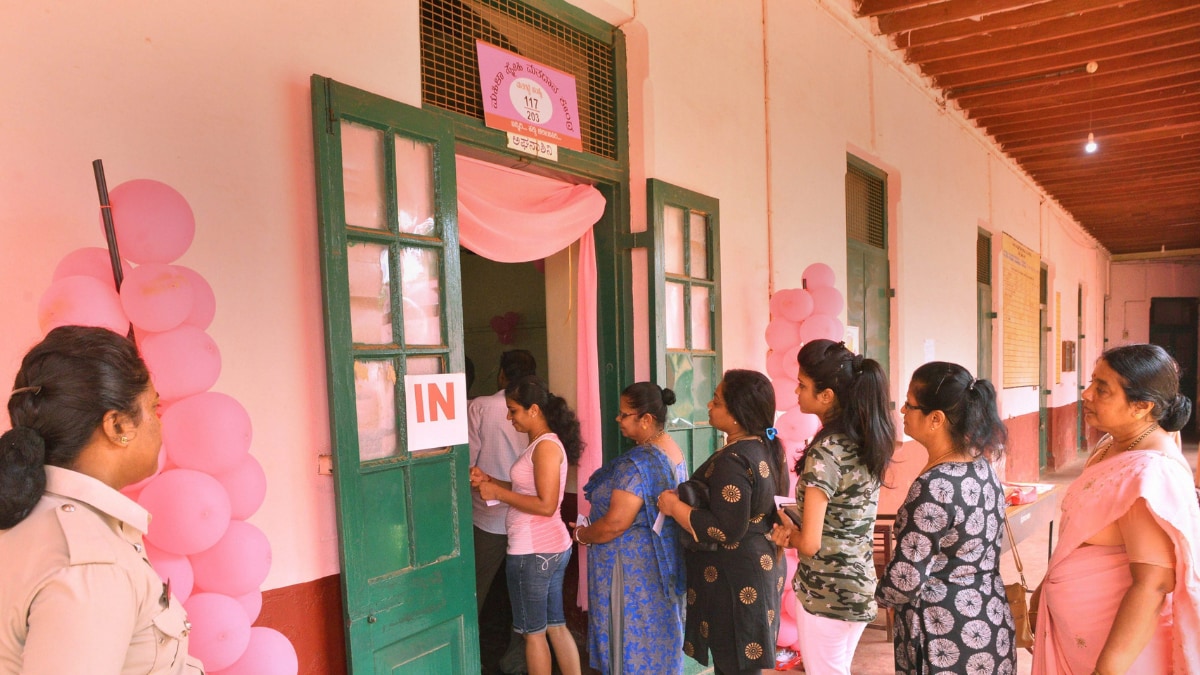Karnataka will see two-phase polling in the Lok Sabha elections after 15 years, but the gap between the two polling dates is 10 days, the longest yet.
The BJP says that the Election Commission’s decision to conduct the general elections spread over 80-odd days was just to ensure free, fair, and safe elections and there’s no need to read much into it. The Congress, on the other hand, call it a pre-planned strategy by the BJP to suit its “political mobilisation”.
Karnataka is one of the most important states for the BJP as it is the only southern state it has been in power in. More importantly, the state sends 25 MPs to the Lok Sabha. The BJP has sealed a partnership with the HD Deve Gowda-led Janata Dal (Secular) in the state. The JD(S) won one seat, Hassan, in the 2019 elections, while the Mandya seat was won by a BJP-backed candidate. In the previous Lok Sabha elections, the JD(S) had contested in alliance with the Congress.
“An election is a celebration of democracy, and it is undoubtedly a mammoth task to conduct elections in one of the world’s biggest democracies,” said Arvind Bellad, Deputy Leader of Opposition, Karnataka.
Bellad added that the long schedule also gives time to the government and political parties to make adequate preparations. “Time is needed to mobilise security forces across for free, fair, and safe elections. One has to campaign, and all leaders must get enough time to campaign and this facilitates that,” he said.
Bengaluru Central’s BJP MP candidate and three-time MP PC Mohan added that the schedule was not unusual. “There is a need to move forces across for deployment during elections. There is nothing to read into.”
In 2004, Lok Sabha polls across the country were held in 21 days, while in Karnataka it was held in two phases – April 20 (15 seats) and April 26 (13 seats). The gap between both phases was a week.
In 2009, it was held over 28 days, while in Karnataka it was once again held in two phases – April 23 (17 seats) and April 30 (11 seats). Here again, the gap between the two phases was seven days.
In 2014, the general elections were held over 37 days and Karnataka went to polls in a single phase on April 17.
In 2019, elections were held over 36 days with Karnataka voting in two phases – April 18 (14 seats) and April 23 (14 seats), a gap of five days.
However, this time, the voting dates in Karnataka are 10 days apart — April 26 (14 seats) and May 7 (14 seats) — which the Congress says is to being done to give the BJP an upper hand.
Karnataka minister Priyank Kharge criticised the election planning as one done to “facilitate the BJP’s supreme leader to be able to tour across”.
“It is evident that it is being done to suit one party alone to divert the machinery, men and money. The Election Commission of India was very clear that the threat to democracy was through the three Ms – money, muscle, and misinformation. The BJP has all three with them and now they are trying to manufacture the mandate,” Kharge told News18.
Kharge added that whatever reason is cited, be it geography, weather, exams, troop movements, it is being done to help the BJP.
“The PM speaks of One Nation-One Election as he claims that productivity goes down and administration comes to a standstill. And then you go ahead and announce one of the longest elections in the history of India,” the Congress leader said.
Bellad countered Kharge’s statement, saying: “If the Congress claims this is to suit the schedule of PM Modi to campaign, what stops the Congress from getting their leader Rahul Gandhi to campaign everywhere?”
N Gopalaswami, former Chief Election Commissioner (CEC), said a minimum of 30 days are required to conduct the elections from the nomination to the declaration of results. He believes there could be a well-thought out strategy and planning for holding a long-drawn election this time. However when many states are going to poll, there is a need for a long-drawn schedule and a proper strategy because each region has its own problems and requirements. Adequate deployment of security personnel, weather conditions, Class 10 and 12 examinations as well as some festivals that may overlap with the dates would also be considered.
“Even with the best of efforts, given the phasing of the elections, it is inevitable that elections will be held not less than 70-odd days,” Gopalaswami explained. “If you want to cover every polling station with a semblance of paramilitary forces, you are bound to run into a shortage as the number of personnel is limited. In central India, where there is Naxal activity, there is heavy deployment. When that is done, the force is not available elsewhere. Then the forces are moved from place to place.”
The former CEC said that security personnel are alternated across states and moved from phase to phase. “The idea is to optimally use them in every phase,” Gopalaswami said.
He further explained the logistical hurdles in security force deployment and movement. “For example, you cannot deploy Tamil Nadu forces in Karnataka due to the Cauvery trouble. Similarly, with Kerala as well. These are certain limitations under which the EC works,” he said.
The former CEC added that polling is preferably not scheduled in a metro city on a Monday or a Friday since people tend to take an extended holiday over the weekend and do not come to vote.
“Generally, voting percentage is lower in metro cities and this would bring it down further. All this needs to be factored in as well,” Gopalaswami said.
In some ‘notorious’ states it is necessary to go for a single-day poll as as “money distributing gangs” travel from one area to another. “So, elections are conducted in one day there. But in states where problem is a different type, like law and order issues or intimidation of voters is a major concern , you need adequate forces in each polling station so the election in that state needs to be held in phases,” he said.
The total duration of the electoral process this year from the day of announcement of the polls by the EC to counting day spans over 82 days. Voting days for the 2024 Lok Sabha polls will span over a period of 44 days as compared to the shortest voting window for a general election in 1980. It lasted merely for four days.






)
